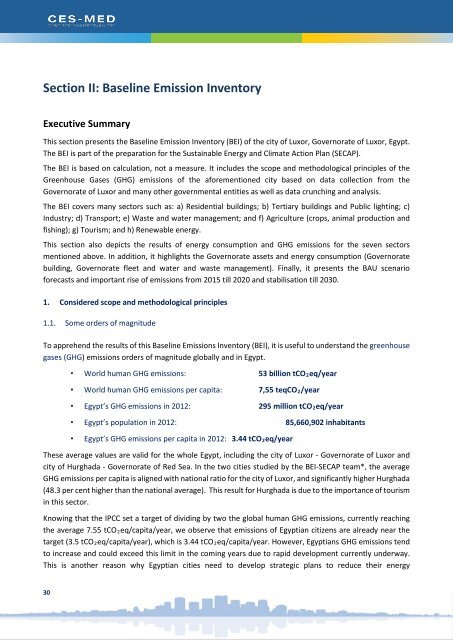280218_Luxor-Egypt SECAP Final_revised
You also want an ePaper? Increase the reach of your titles
YUMPU automatically turns print PDFs into web optimized ePapers that Google loves.
Section II: Baseline Emission Inventory<br />
Executive Summary<br />
This section presents the Baseline Emission Inventory (BEI) of the city of <strong>Luxor</strong>, Governorate of <strong>Luxor</strong>, <strong>Egypt</strong>.<br />
The BEI is part of the preparation for the Sustainable Energy and Climate Action Plan (<strong>SECAP</strong>).<br />
The BEI is based on calculation, not a measure. It includes the scope and methodological principles of the<br />
Greenhouse Gases (GHG) emissions of the aforementioned city based on data collection from the<br />
Governorate of <strong>Luxor</strong> and many other governmental entities as well as data crunching and analysis.<br />
The BEI covers many sectors such as: a) Residential buildings; b) Tertiary buildings and Public lighting; c)<br />
Industry; d) Transport; e) Waste and water management; and f) Agriculture (crops, animal production and<br />
fishing); g) Tourism; and h) Renewable energy.<br />
This section also depicts the results of energy consumption and GHG emissions for the seven sectors<br />
mentioned above. In addition, it highlights the Governorate assets and energy consumption (Governorate<br />
building, Governorate fleet and water and waste management). <strong>Final</strong>ly, it presents the BAU scenario<br />
forecasts and important rise of emissions from 2015 till 2020 and stabilisation till 2030.<br />
1. Considered scope and methodological principles<br />
1.1. Some orders of magnitude<br />
To apprehend the results of this Baseline Emissions Inventory (BEI), it is useful to understand the greenhouse<br />
gases (GHG) emissions orders of magnitude globally and in <strong>Egypt</strong>.<br />
• World human GHG emissions: 53 billion tCO 2eq/year<br />
• World human GHG emissions per capita: 7,55 teqCO 2/year<br />
• <strong>Egypt</strong>’s GHG emissions in 2012: 295 million tCO 2eq/year<br />
• <strong>Egypt</strong>’s population in 2012: 85,660,902 inhabitants<br />
• <strong>Egypt</strong>’s GHG emissions per capita in 2012: 3.44 tCO 2eq/year<br />
These average values are valid for the whole <strong>Egypt</strong>, including the city of <strong>Luxor</strong> - Governorate of <strong>Luxor</strong> and<br />
city of Hurghada - Governorate of Red Sea. In the two cities studied by the BEI-<strong>SECAP</strong> team*, the average<br />
GHG emissions per capita is aligned with national ratio for the city of <strong>Luxor</strong>, and significantly higher Hurghada<br />
(48.3 per cent higher than the national average). This result for Hurghada is due to the importance of tourism<br />
in this sector.<br />
Knowing that the IPCC set a target of dividing by two the global human GHG emissions, currently reaching<br />
the average 7.55 tCO 2eq/capita/year, we observe that emissions of <strong>Egypt</strong>ian citizens are already near the<br />
target (3.5 tCO 2eq/capita/year), which is 3.44 tCO 2eq/capita/year. However, <strong>Egypt</strong>ians GHG emissions tend<br />
to increase and could exceed this limit in the coming years due to rapid development currently underway.<br />
This is another reason why <strong>Egypt</strong>ian cities need to develop strategic plans to reduce their energy<br />
30

















